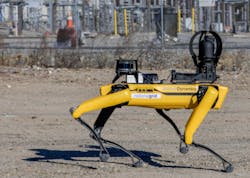They’re back in the news again! NASA’s Mars rover Perseverance and the Mars chopper Ingenuity have been making headlines once more. This autonomous robotic duo has captured a lot of attention with their remarkable feats starting with the amazing landing in Jezero Crater and now Ingenuity’s flights across the Martian landscape. As of this writing, Ingenuity has accomplished all of its primary objectives during its first three flights. As a result, it has been cleared to fly sorties beyond its original missions.
Ingenuity’s expanded missions includes scouting, stereo imaging, and digital elevation maps. A spokesperson said, “This will provide a perspective that only an aerial dimension can give.” This combination of a ground-based rover and flying drone has so many applications for substation inspection and security robotics. Imagine being able to bring LiDAR, infrared, and other technologies from above and below to inspect substation equipment.
The possibilities are limitless for autonomous drones and rovers to work as an inspection team from above and on the ground in a substation, so I decided to dig deeper. I ran across some interesting information concerning substation robots. It hasn’t been that long ago I wrote about this subject, but cruising the web always turns up something interesting. One interesting tidbit came from a marketing group.
The group reported that the global market for substation inspection robots was becoming a growing technology. Its report said 2020 was a growth year with substation owners spending about US$174 million for robotic inspection devices. It projected that in the next five years worldwide spending would reach about $294 million.
Spot the Robot
Another piece that popped up was a report from National Grid that appeared in T&D World earlier in the year (https://tdworld.com/21152823). National Grid has been investigating substation robotics. It is examining Boston Dynamic’s Spot, the quadruped robot at their Sandy Pond 2,000 megawatt (MW) HVDC (high voltage direct current) converter station. Hmm, robots and HVDC – two of my favorite things in one place. This has to be dug into deeper.
According to the report, “Spot the robot dog has a shiny yellow coat with bandy legs, and has a zoom camera for a head.” National Grid has been using Spot to carry out critical safety inspections at the facility’s high-voltage switchyards. The robot is equipped with both a high-resolution 30X optical zoom pan/tilt/zoom camera and an infrared (IR) camera to detect signs of potential problems. It also has LiDAR for measuring distances.
I still remember my first visit to Sandy Pond converter station. I was a member of ABB’s (now Hitachi ABB), HVDC Users Group. One year our annual meeting was held in Boston, not far from Sandy Pond, which was one of the newest HVDC facilities. As the manufacturer, ABB arranged a day trip to Sandy Pond. It was enormous, encompassing a 450 kV (kilovolt) DC switchyard, a 345 kV AC switchyard, and a five-story building containing the valve hall and associated support functions.
Anyone who has ever worked in an HVDC converter station can tell you there is an insane amount of equipment that needs constant monitoring and inspection. National Grid mentioned one task that caught my attention. It wanted to use Spot inside Sandy Pond’s valve hall to inspect for water leaks and hot spots.
To do that National Grid had to do a great deal of research into the effects of electrical fields on the robot’s electronics and the effects of the robot on the sensitive thyristors. All of its testing was successful, and Spot was allowed in the energized valve hall, which National Grid said was where the robot really proved its worth.
An energized valve hall is a highly electrified area and as a rule people are not allowed inside during operation. I have been inside energized valve halls several times with an infrared camera looking for hot spots, and it was a never comfortable experience. Using a robot for that kind of work is much preferable.
By sending Spot inside the energized valve hall, technicians could conduct visual and thermal inspections from outside the valve hall. They could immediately determine if maintenance or repair work was needed and where it was needed. In addition they knew what parts had to be ordered. This advanced inspection provided information that would shorten their next maintenance outage, which is a huge plus when dealing with critical elements of the grid. I can’t wait to see how this develops as more utilities deploy these robots!
About the Author
Gene Wolf
Technical Editor
Gene Wolf has been designing and building substations and other high technology facilities for over 32 years. He received his BSEE from Wichita State University. He received his MSEE from New Mexico State University. He is a registered professional engineer in the states of California and New Mexico. He started his career as a substation engineer for Kansas Gas and Electric, retired as the Principal Engineer of Stations for Public Service Company of New Mexico recently, and founded Lone Wolf Engineering, LLC an engineering consulting company.
Gene is widely recognized as a technical leader in the electric power industry. Gene is a fellow of the IEEE. He is the former Chairman of the IEEE PES T&D Committee. He has held the position of the Chairman of the HVDC & FACTS Subcommittee and membership in many T&D working groups. Gene is also active in renewable energy. He sponsored the formation of the “Integration of Renewable Energy into the Transmission & Distribution Grids” subcommittee and the “Intelligent Grid Transmission and Distribution” subcommittee within the Transmission and Distribution committee.
